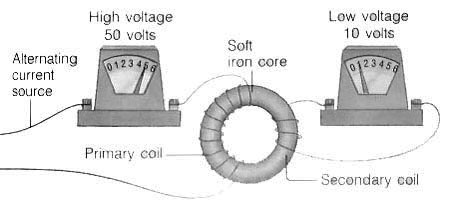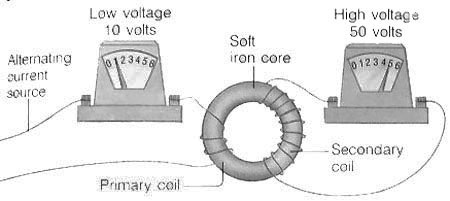How do Transformers Work?
What is Electromagnetic Induction?
If magnetism can be produced from electricity it was hypothesized by Faraday that electricity can be produced by magnetism. Faraday used an apparatus consisting of soft iron core similar to that shown below. The coil on the left was connected to a battery and the coil on the right was connected to a galvanometer. When the current flows through the left coil connected to the battery a magnetic field is produced. The strength of the magnetic field is increased by the iron core. Although Faraday was not able to produce a current in the left wire, but strangely he noticed that current was produced when the current changed. Faraday concluded that although a steady magnetic field produced no electric current, a change in magnetic field did produce a current. Such a current is called an induced current. The process by which a current is produced by changes in magnetic fields is called electromagnetic induction.
Note: Electromagnetic Induction was discover independently by Michael Faraday and Joseph Henry in 1831. The relationship between between electromotive force EMF (voltage) and magnetic flux was formalized in an equation now referred to as Faradays law of induction
How transformers work
A transformer is a device that increases or decreases voltage of alternating current. The current in one coil induces a current in another coil.
A transformer consists of two coils (one coil is the primary coil the other is the secondary coil) wrapped around a metal core. (see images ---) When an alternating current passes through the primary coil and magnetic field in induced -- electromagnetic induction causes a current to flow in the secondary coil. If the number of loops of wire is the same in both coils the induced voltage will be the same in the secondary coil. If the number of loops in the secondary coil are greater than the primary coil the voltage will be greater in the secondary coil. This is an example of a step up transformer.
How the number of loops affect voltage?
If the number of loops in the secondary coil is less than the primary than the voltage will be less. The is called a step down transformer.
STEP DOWN TRANSFORM 10 COILS TO 2 COILS 5:1 VOLTS

If the number of loops in the secondary coil is more than the primary than the voltage will be more . The is called a step up transformer.
STEP UP TRANSFORMER 2 COILS TO 10 COILS 1:5 VOLTS

Why transformers are important in transmission of electricity.
Step up transformers are used by companies during the transmission of electricity over power lines. Companies then use step down transformers to create the 120v used in homes. Step up transformers are also used in home television sets where high voltage is needed. Step down transformers are also used in radios and computers and calculators
Test your Understanding:
Electricity, Magnetism and Electromagnetism
- Electricity and Magnetism Home
- Electric Charge
- Coulombs L;rent
- Electric Circuits
- Electric Power
- The Nature of Magnets
- Earth as a Magnet
- Magnetism in Action
- Magnetism from Electricity
- Electricity from Magnetism
- How do Transformers Work?
- Ohms Law Lab
- Magnetic Forces Lab
- Why Metals Conduct Electricity
- How does a Battery Work
- How does an Electric Motor Work
Science of Fluids
- Science of Fluids
- What are Fluids?
- What is Pressure?
- What is Hydrostatic Pressure?
- Surface Tension and Capillary Action
- Pascals Principle
- Archimedes Principle
- What is Viscosity?
- Bernouili's Principle